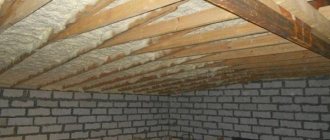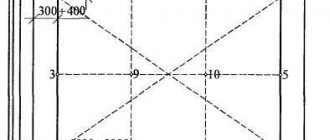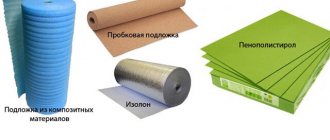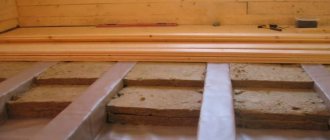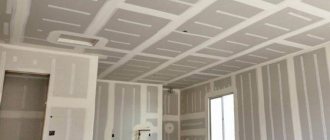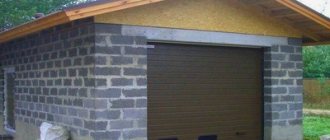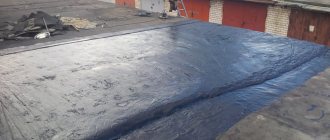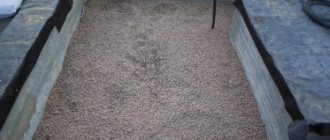Selection of material for insulation
Now let's talk about the best way to insulate the ceiling in the garage.
The choice of thermal insulators directly depends on the wall material and installation method. It is especially important to think through the technology for installing the insulator before insulating the ceiling in the garage with your own hands. For example, sprayed polyurethane foam has excellent thermal insulation characteristics, but it is impossible to install it yourself because it requires special equipment and certain skills
For concrete surface
You can insulate the ceiling in a garage from the inside onto concrete using the following materials:
- expanded polystyrene;
- mineral and basalt wool;
- liquid insulation (paints and sprayed polyurethane foam);
- foil insulators.
To install a heat insulator on a concrete base, you can use frame and frameless technology. Foil insulators by themselves are insufficiently effective, but they simultaneously perform the functions of vapor and waterproofing and have a reflective layer of aluminum foil. Therefore, if they are used in conjunction with other insulation, the effectiveness of such thermal insulation increases significantly.
If we talk about how to insulate the ceiling in a garage from the inside inexpensively, then mineral wool is optimally suited for these purposes.
Its only drawback is a decrease in thermal insulation characteristics due to moisture absorption, which is why it is so important to perform high-quality hydro- and vapor barrier. If you use mineral wool in combination with a foil insulator, the room is reliably protected from cold and heat, as well as condensing moisture
Materials for a metal garage
Thermal insulation of the ceiling in a metal garage can only be installed using a frameless method, because it is impossible to drill holes for fixing the load-bearing sheathing in thin metal enclosing structures. Because of this, only the following materials are suitable for insulating the ceiling of a metal garage:
- expanded polystyrene;
- sprayed polyurethane foam.
Since the latest insulation requires only professional installation and is not cheap, you can use polystyrene foam for insulation yourself.
Foam plastic for garage insulation
The optimal choice for thermal insulation of garage walls is polystyrene foam. It is simple and easy to install compared to any fibrous material. Polystyrene foam is lightweight and durable. It has two undoubted advantages over any fibrous materials:
- it is non-hygroscopic;
- does not shrink.
This material has sufficient vapor permeability so that the room does not turn into a thermos. But despite this, you will need to provide high-quality ventilation in the garage. In order to insulate the walls, you can choose any sheet foam.
But you should know that the higher its density, the lower the thermal conductivity will be.
The most inexpensive foam type is C15 with a density of 15 kg/m³. There are other brands: C25, C35 and C50. As the density increases, the price of the material also increases. Canvases of any brand are produced in the following sizes:
Penoizol insulation scheme.
- thickness from 3 to 50 cm in increments of 10 mm;
- sheet dimensions: 1x1 m, 1x1.2 m, 1x2 m.
Using polystyrene foam you can quickly and efficiently insulate your garage with your own hands.
This material does not require special skills for its installation. The light weight of the canvases allows you to lay them yourself, without resorting to outside help. In order to insulate a garage from the outside with polystyrene foam, no additional costs are required for the purchase of vapor and moisture-proof membranes. But finishing materials are needed: siding, facade panels, metal profiles.
Types of insulation and their indicators
How to level walls correctly with your own hands Video on how to level walls correctly How to level walls with your own hands using beacons video How to level walls using a rule How to level clay walls What mortar to use to level walls
Let's look at several materials that can be used to insulate a garage from the inside:
- Expanded polystyrene boards. This insulation has a thermal conductivity of 0.037 W/m*K.
- Mineral wool – 0.039 W/m*K.
- Brick – 0.52.
- Cinder block - 0.65.
That is, it turns out that polystyrene foam is the ideal option when it comes to thermal insulation of the garage from the inside. They can be used to decorate walls, floors, ceilings and gates. But what about the thermal inertia indicator? Here the situation is the other way around. What is the essence of this indicator?
The higher it is, the slower the body of the structural element heats up or cools down. For example, cinder block walls are the best option for a garage. In addition, if you do external and internal plaster. And if you line them with polystyrene foam from the inside, then such a garage will be considered maximally insulated.
It turns out that the insulation is a kind of protective barrier against the penetration of cold into the garage, and thick plastered cinder block walls are temperature keepers. In general, it turns out something like a thermos.
Insulation of a concrete garage is the key to safe vehicle storage
There are a lot of materials used for insulation, of which there are a great variety on the market today. Polystyrene foam is the most affordable means of insulation. It is light, cheap, relatively durable, can be processed without much difficulty, is easy to install, but is flammable and fragile. Expanded polystyrene, in essence, is not much different from polystyrene foam, only with a stronger internal structure and not as flammable. Due to the mentioned factors, polystyrene foam is relatively more expensive.
Basalt (mineral) wool is characterized by deep internal hygroscopicity. For this reason, it absorbs and accumulates moisture, which serves as a favorable condition for the appearance of fungus. A concrete garage is not a place for mold, and the cotton wool crumbles over time. All this contributes to the deterioration of thermal insulation, both external and internal.
As for organic seals, they are made from natural raw materials (linen, cotton, hemp). They are predominantly endowed with a fibrous internal structure, although compared to cotton wool, organics are flammable.
So, the most rational solution is to insulate both the outside and the inside with foam plastic or a substance with similar properties. Among other things, it is moisture resistant. This circumstance is especially relevant for dark, cold (not heated) rooms, where it is impossible to influence the relative humidity indicator. And if there is a heating installation in a concrete garage, the adjacent walls should be insulated with glass wool (mineral wool) for fire safety reasons. This will prevent overheating and subsequent fire of the insulation. It is also worth remembering that its heat capacity directly depends on the outer thickness of the insulator.
The inside lining can be plasterboard, which is not afraid of dampness, and the outside can be a layer of plaster. True, drywall will require preliminary installation of an internal frame from a convenient steel profile (for the external method, a frame is not required). First, solid sheets are installed, then shreds. Drywall is cut with a utility knife.
Before treating the walls, all protruding elements must be removed from them, and if there are cracks or holes, concrete mortar is poured into them. The method of frame installation depends on which type of seal is chosen. For example, cotton wool is attached to self-tapping dowels, and foam plastic is attached to an adhesive base.
Dust and dirt are removed from the walls and primed. After drying, the actual installation begins. The layer is built up from the bottom up, and grooves are cut between the metal profiles to install the sheets. Primus type glue is spread over the foam using a calibrating spatula. Since foam plastic breaks easily, it should not be pressed from the outside for better fixation! After drying, the layer is sometimes secured with dowel screws with wide heads for greater reliability.
In the case of mineral wool, a profile is attached below at the level of the baseboard: then the wool will not touch the floor and absorb moisture. The blanks are cut approximately a couple of centimeters larger than the size of the interprofile openings. Then the fiber is laid in these openings and also secured with dowels with self-tapping screws with wide plastic caps.
From the perspective of the material from which the garage is built
Insulating walls with foam plastic from the outside, how to insulate a house with your own hands, technology, video instructions for external installation
The table shows the thermal conductivity of materials that are often used for the construction of garages (concrete, foam concrete, expanded clay concrete, aerated concrete, reinforced concrete, brick, metal structures, wood, timber, logs, corrugated board, chipboard, OSB). The table shows that each material has its own thermal conductivity indicators, which leaves its mark on the choice of thermal insulation material.
Table of thermal conductivity of building materials
insulation of an iron garage. The building material is thick and dense sheet iron. In this case, insulation is mandatory, because this is the coldest type of construction, which means it requires the use of high-density materials and significant thickness, for example, foam plastic with a density of 25 kg/m3, 100 mm thick;
insulation of a metal garage. For construction, corrugated sheets or thin sheet metal are used. Such material similarly requires the use of a thick layer of thermal insulation;
insulation of a concrete garage. Concrete walls have a thickness of at least 200 mm. and can be formed from blocks or by pouring monolithic concrete mortar. Concrete is a good conductor of heat, so the thermal insulation of surfaces must be taken seriously;
insulation of a brick garage. Bricks of different types and densities are used, and, accordingly, with different thermal conductivity indicators. For example, a garage made of hollow brick is warmer and can be insulated with polystyrene foam, while a garage made of silicate brick is colder and requires the use of polystyrene foam;
insulation of a wooden garage. Wood can store heat for a long time, but is subject to deformation over time. Insulation technology largely boils down to eliminating cracks. As a rule, insulation of a wooden garage is carried out with soft insulation materials;
insulation of a frame garage. Regardless of the material from which the frame is made, the technology of its manufacture itself provides for the possibility of installing insulation between the frame supports. At the same time, soft insulation is traditionally used for a wooden frame, and hard insulation is used for a metal frame (foam plastic, expanded polystyrene or foam boards).
From the point of view of the location of the insulation
This is an important aspect, because Each type of insulation has its own advantages and disadvantages. Pros and cons of thermal insulation from the outside (from the street) and from the inside (from the inside), comparison, when which method is justified or advisable.
Insulating the garage from the outside
A method recommended by both masters and users based on practical experience.
Advantages of external insulation:
- the likelihood of garage walls freezing is reduced. The freezing point shifts towards the insulation. Among other things, this increases the service life of the walls themselves;
- the risk of condensation formation is reduced;
- a favorable environment for the development of fungi is eliminated;
- the area of the premises remains unchanged;
- there is no need to dismantle the shelves and take everything out for work;
- harmful effects on humans of fumes from insulation materials are eliminated;
- the cost and labor intensity of work is reduced.
Insulating the garage from the inside
This method is used when:
- It is not possible to perform external (external) insulation. For example, a garage is located in a block, i.e. located between other garages and has common walls with them;
- there is no possibility or desire to dismantle the shelves indoors;
- Sprayed thermal insulation material (polyurethane foam, polyurethane foam or penoizol) will be used as insulation. Having a minimum thickness, sprayed thermal insulation does not affect the usable area and, due to its excellent adhesion to the surface, eliminates the appearance of condensation on the walls and ceiling.
Disadvantages of internal insulation:
- reducing the usable area of the garage;
- displacement of the freezing point inside the room, at the junction of the insulation to the wall. The result is the gradual destruction of the garage walls.
Thus, if possible, it is better to give preference to the external method of insulation.
Insulating the garage from the outside
Insulating the garage wall from the outside with polystyrene foam
Many experts consider external insulation to be the most suitable and effective method. The following arguments support this:
- The risk of walls freezing is almost completely eliminated.
- Resistance to condensation between the wall and the insulation.
- There is no environment for the formation of mold and fungal compounds.
- Saving space indoors.
- No harmful fumes.
The most common material for external insulation is polystyrene foam. For this method, it is necessary to prepare the surface of the walls well.
Important: it is necessary to store polystyrene foam and its derivatives without exposure to sunlight, since under their influence it is destroyed and loses its basic properties.
It is necessary to first clean the surface from chips, repair potholes and oil stains. In some cases, an adhesive solution can be used for leveling. Then allow time to dry and apply a layer of special primer.
Now you should move directly to insulation. A profile under the starting row is attached to the bottom. Then the remaining rows are installed and the top profile is installed. Glue is applied to sheets of foam plastic (expanded polystyrene). This is done using a notched trowel over the entire surface evenly, or pointwise, with a small amount of glue. Install the foxes by adjusting their position by level.
It is better to lay the foam in a checkerboard pattern, carefully pressing it against each other. The glue is allowed to dry completely for three to four days, and then the sheets are additionally secured with dowels.
To maintain high thermal protection properties and eliminate the possibility of moisture ingress, additional surface finishing is necessary. You can use traditional plaster or the now popular siding finish.
Important: the garage must have a ventilation system installed to avoid the accumulation of harmful carbon monoxide and excessive humidity.
Foam insulation technology
Polystyrene foam is a fairly popular material, which contains 90% air and 10% polymer. Because of this, insulating walls from the outside with foam plastic has low thermal conductivity, the material is easy to use and has a fairly low cost. The thickness of the foam can be 5 and 10 cm, you need to choose it taking into account the characteristics of the house.
Before you start insulating walls with foam plastic, you need to prepare them. The wall must be leveled, because if there are grooves or depressions, the sheet may break or lie unevenly. The optimal size of protrusions or depressions is no more than 2 cm.
After plastering the wall, pay attention to its texture: it should be rough for stronger adhesion to the glue. In cases where the wall is painted with zero vapor permeable paint, it will need to be cleaned and only then primed
It is necessary to prime the wall in any condition, because this will create an additional layer of strengthening. Before insulating with foam plastic from the inside, the walls also need to be leveled.
You only need to prepare polystyrene foam if you have chosen high-density polystyrene foam (penoplex). This type is distinguished by the fact that it has a smoother surface, and for tight fastening it must be processed with a roller with needles. And only after this the sheets can be attached to the wall. But if you chose ordinary, then this is not necessary. Fastening must be done using special glue.
The technology for insulating walls with foam plastic remains unchanged. At the bottom of the wall, it is necessary to fix the starting profile horizontally; it will prevent the sheets from slipping. Then apply glue to the wall according to the size of the sheet and to the sheet itself (on all 4 corners and several points in the middle). Then press the sheet against the wall, hold it for a few seconds, then move on to the next one.
When the insulation of the wall from the outside comes to an end, it is necessary to lubricate the seams with glue and lay down the reinforcing mesh. After it dries, you need to plaster the seams.
Sprayed materials for insulation
A modern approach to insulating walls and roofs is the use of sprayed materials. Their advantage is that they are seamless. This eliminates the formation of cold bridges. Therefore, such materials are the best, but also the most expensive choice for insulating a garage inside and out.
There are several types of sprayed materials:
Foam insulation scheme.
- urea-formaldehyde foam (penoizol);
- polyurethane foam (PPU);
- ceramic liquid thermal insulation
To apply spray-on thermal insulation, a foam generator is required. The thickness of the applied layer can be any: from 2 to 20 cm. The choice depends on the climatic characteristics of the region. The liquid composition is obtained by mixing the powder with water and heating the mixture. An important condition for carrying out work is positive air temperature.
The insulation is applied in layers. The thickness of each layer should not exceed 1.5 cm. Work begins with hard-to-reach places: upper corners, ventilation grilles, window openings. The entire volume of prepared sprayed thermal insulation must be produced in 1 work shift.
The benefits of garage insulation
Faced with the first problems (freezing, low temperature inside, condensation of liquid in summer, uselessness of the heater), some garage owners are trying to get rid of the property. Unfortunately, there is an easier way to overcome the difficulties that have arisen. Insulating your garage will bring the following benefits:
- will extend the service life of the structure, since it will eliminate the appearance of mold, dampness, and prevent freezing;
- it will become more pleasant and warmer to carry out any work (for example, repairing a car);
- the vehicle inside the garage will not be exposed to dampness and subsequent rust;
- Inside the warm box you can store many items that are temporarily not needed at home.
The advantages of using insulation are obvious. Now it’s worth considering the most popular of them.
Expanded polystyrene and foam plastic
These two insulation materials are considered related. The differences between them are in some of their characteristics, as well as in price. At the same time, the technology for working with both polymers remains unchanged. On the building materials market there is also such a name for insulation as penoplex. It is a trademark of a Russian manufacturer producing extruded polystyrene foam. But it's the same material.
The required amount of foam used to seal the seams will directly depend on how tightly the insulation panels are laid and on the number of resulting edges. It should also be noted that this composition is suitable for correcting inaccuracies after laying the insulating layer. That is why you need to buy it a little more than calculated.
Gate insulation
It is not enough to cover only the walls and ceiling with thermal insulation material in the garage.
When planning work, you should pay attention to the gates. They are very large, which leads to a considerable amount of heat being lost through them.
Insulating the garage door from the inside with your own hands is necessary because otherwise it will be quite difficult to heat the structure.
At the initial stage, a small door is made in one of the gate leaves. This will prevent you from constantly opening the gate, which will also save heat. A curtain made of thick fabric or plastic can be reinforced between the opening doors and the room. This device will also help retain heat in the room. In this case, it is recommended to take transparent plastic, which will allow the driver leaving the garage to have a good orientation. Thick polyethylene film, more than 0.8 millimeters thick, is suitable for this. The material is cut into strips. Their length should be almost equal to the height of the room, not reaching the floor by one centimeter. The width of such strips is 20-30 cm. If the film is cut narrower, it will cling to the exterior mirrors and other protruding parts of the car. It will be very inconvenient.
To attach the strips to the ceiling, a wooden strip is nailed. And then you will need a stapler. With its help, the strips are attached to the rail with an overlap of 1.5-2 cm or a little more. Under the weight of its weight, the film should hang evenly, and after deflection it should return to its place.
It is recommended to insulate garage door panels with polystyrene foam. To carry out the work you will need to make a crate. At the next stage, all its gaps are filled with thermal insulation material. In order to prevent cold air masses from entering the garage, the gaps that form at the junction of the gate should be treated with adhesive tape.
Elimination of drafts becomes possible with the use of rubber seals. After insulation, condensation begins to form on the door leafs, where the insulation and metal come into contact. In this regard, the opening doors are coated with anti-corrosion protection. The frame parts should also be primed. This will protect them from fungus and warping. For this purpose, heated drying oil is used. The foam layer on the gate is covered with durable material. Such cladding can be made of thin boards or OSB. It is not recommended to use moisture-resistant material.
The nuances of selecting and further self-installation of insulation in the garage were discussed above. The described technologies are optimal for most owners of such structures, since they do not require significant financial investments and allow them to solve the problem. The main thing that is required is to follow the instructions and avoid tears and cracks in the heat-insulating layer. This is the only way to eliminate the penetration of cold air into the garage and ensure normal temperature conditions in it, which will delight the owners of the building not only in winter, but also in summer.
Do-it-yourself garage insulation
For reliable thermal insulation of a garage, it is necessary to protect not only the walls, you will also need to insulate the floor, entrance gate, floor surface and ceiling . The range of materials suitable for this is huge, and you can choose what you need for a particular building. Most often they choose mineral wool or polystyrene foam, and the floor is mainly insulated with expanded clay.
It makes sense to combine different thermal insulators, since building structures are built from different materials.
Floor insulation
The floor in the garage is most often made of concrete, so it is advisable to insulate it during pouring . If you purchased a ready-made garage, then it will be difficult to protect the floor from the cold, since during work its surface will become much higher. An alternative is to remove some of the soil and lower the floor level.
Sequence of work:
- The soil is leveled and compacted well;
- A 10-20 cm layer of sand is poured, and this is also thoroughly compacted;
- A concrete screed is made over the finished sand cushion, after which they wait for the solution to set;
- Expanded clay is used as a heat insulator;
- The insulation is mixed with cement and a concrete solution is prepared on this basis;
- Pour the resulting mixture onto the floor and wait until the surface hardens;
- Upon completion of the work, a finishing screed is made.
The finished floor should not be used for about a month - this period is necessary for high-quality hardening of the concrete.
Ceiling insulation
Warm air, according to the laws of physics, rises, so the ceiling must be insulated. For this, it is best to use polystyrene foam.
The sequence of work is as follows:
- The choice of fastening method depends on the floor material. You can attach foam plastic to a wooden ceiling with simple nails. On the concrete floor, you must first make a frame in which the heat-insulating material is placed. In this case, the foam can be secured with tape and then covered with plywood or decorative sheathing;
- All gaps and cracks are sealed with foam;
- The plywood surface on the ceiling is impregnated with antiseptics, cleaned well and then painted.
Thermal insulation of walls
To insulate metal walls, you must first straighten the bent areas. As a heat insulator, it is advisable to use heat-insulating paint, polyurethane foam or polystyrene foam. For garages built from brick or cinder block, mineral wool is mainly used.
Sequence of work with mineral wool:
- The walls are cleaned, the frame is prepared;
- Heat-insulating material is placed into the finished frame, securing it with special hooks;
- The insulation is covered with a vapor barrier material;
- Any decorative finish is suitable; it is installed after laying the vapor barrier layer.
- The surface is leveled and prepared;
- Attach the foam with glue, pressing evenly over the entire area;
- The sheets must be placed end-to-end, sealing all gaps with foam;
- After the foam has hardened, all protruding excess is removed;
- The walls are puttied and covered with suitable paint.
Attention! Do not forget that foam plastic begins to release toxic compounds into the air during a fire. It is necessary to follow safety rules and be sure to have a working fire extinguisher ready in the garage.
Gate insulation
It is convenient to protect metal gate leaves from the cold using polystyrene foam. It’s a good idea to make a thermal curtain; to do this, hang a thick film or thick fabric in front of the gate.
The sequence of work on gate insulation is as follows:
- First of all, a sheathing is made on the gate, after which sheets of insulation are fixed into it using dowels or glue;
- Any gaps, seams and joints between the sheets are sealed with foam to eliminate cold bridges;
- The foam placed in the sheathing is leveled with putty, covered with paint or protected with sheets of decorative sheathing;
- After this, polyethylene strips 20-30 cm wide are suspended in front of the gate as a thermal curtain over the entire height of the garage.
Each garage owner decides independently how it is convenient for him to insulate the garage. It is important to choose a reliable method of protection from the cold. The best thing is to seek advice from professionals who will help you choose the right materials so that insulating your garage will cost you little, and the thermal insulation will be durable and effective.
Stages of insulation
If you decide to cover the box with thermal insulation materials, this must be done comprehensively, because the surfaces left unattended will conduct warm air through themselves, and the garage will freeze out. The gates, walls, ceiling and floor are processed alternately with the material.
Gates
A simple way to insulate the entrance to the garage is to pull a curtain from the inside. To do this, select a dense fabric (for example, polyethylene with a thickness of 0.8-1 mm), then the sequence is as follows:
- next to the gate, a wooden strip is nailed to the ceiling;
- polyethylene is cut into strips 20-25 cm wide; the length should be such that its ends do not touch the floor;
- the strips are attached to the rail with a stapler with a slight overlap (2-3 cm);
- Instead of polyethylene, it is permissible to use thick fabric, but this is not entirely correct; movement will be carried out blindly when the driver drives the car out of the garage.
Another, more thorough method involves insulating the door leaf with foam plastic. For this:
- Initially, the metal surface is covered with solid (roofing felt) or liquid (sprayed) material;
- thin wooden planks, pre-treated with an antifungal solution (usually drying oil is used), are attached to the inner surface; if the gate has corners for fixing foam sheets, there is no need to nail the slats;
- Glue is applied on top of the insulation, then the sheets are glued to the surface;
- cracks and joints are covered with mounting foam (without toluene) or sealant;
- boards, lining or other finishing materials are attached on top of the insulation layer.
External walls
To prevent precipitation and wind from interfering with a comfortable stay in the garage, it is necessary to sheathe the outside of the brick garage. The sequence of actions is as follows:
- the walls are cleaned of dirt and dust;
- then they are aligned as much as possible to facilitate the adhesion of the foam to them;
- a primer is applied over the external walls to enhance adhesion;
- a wooden plank is attached to the bottom (distance 2-4 cm from the ground) so that the foam does not interact with the ground;
- insulation sheets are lubricated with bitumen mastic or glue (liquid nails are acceptable) around the perimeter;
- a spatula is used to distribute the glue over the surface;
- the sheet is pressed tightly against the brick wall;
- for reliability, you can tighten the dowels along the edges and center of the slab, but only after the glue has dried;
- a mounting mesh is attached on top of the foam (protection from rodents);
- treating the seams with sealant to prevent the foam from peeling off;
- further actions are at the user's discretion - applying plaster, covering with fiberboard, clapboard, plastic panels or decorative bricks.
The sequence of actions repeats the cladding of the walls from the outside, only you can do without the mounting grid.
Ceiling
Warm air evaporates upward, so the roof also needs to be insulated. If there is a gable roof on top of the garage, it would be correct to insulate the attic. For this:
- a sheathing of 3-5 cm thick bars is placed on top of the attic floor, where each cell is the same size as a sheet of polystyrene foam (or mineral wool);
- insulation is placed inside the cells;
- if there are gaps, fill them with polyurethane foam and wait until dry;
- tape the seams;
- when using cotton wool (any kind), it is necessary to apply another layer of waterproofing; this is not done when sheathing with foam plastic;
- Finishing materials (usually simple, flat boards) are attached on top of the “pie.”
How to insulate a garage roof if there is no gable roof? Only foam plastic fixed to the ceiling in the same way as the walls will help here. A lightweight material (plywood, for example) is attached on top of the insulation; heavy ones can simply fall off after a while.
Floor
If there is a caisson under the garage for storing food, the lower surface of the box is not lined with thermal insulation material. If this is not available, you will have to insulate the floor in the garage. To do this, it is deepened down 20-30 cm, leveled, then covered with crushed stone (the layer is 10 cm). Next, apply a layer of sand (5 cm), and pour bitumen on top of it for the remaining distance until the floor is completely leveled.
By following the above instructions for selecting and organizing the process, even a beginner will understand how to insulate a garage roof, walls, floor and gates. Consistent completion of the work will allow the box to be sheathed with heat-insulating materials correctly, moderately quickly, after which the structure will gain the coziness and comfort that it so lacked.
The nuances of proper garage insulation
The service life of a vehicle depends not only on operating conditions or repairs, but also on proper storage. Many of the drivers have already acquired garages for their vehicles, but not many have taken care to ensure that the car is “comfortable” in the garage.
The garage itself only protects the car from winds and rain; proper insulation of the room will help protect the car from corrosion and increase its service life.
What should be the temperature inside the garage?
Important factors affecting the safety of a vehicle are indoor temperature and humidity.
Important factors affecting the safety of a vehicle are indoor temperature and humidity. Many car enthusiasts, when installing heaters, believe that the warmer it is in the garage in winter, the better for the vehicle. But in fact, the car will only suffer even more if the temperature difference between the garage and the street is large.
Often, due to significant temperature changes, the metal parts of the car suffer, condensation can form on its surface, and excess moisture is also undesirable. Increased humidity in the garage will cause rust to appear much earlier. The optimal option would be when the temperature inside the garage is slightly higher than outside, while maintaining a positive value.
To ensure optimal conditions for storing a car, it is necessary to properly insulate the garage both inside and outside, and do not forget about organizing proper ventilation of the room.
The issue of insulation can be solved in two ways: thermal insulation of the garage from the inside and insulation of the garage from the outside.
Insulation from the inside
When insulating a garage from the inside, it is necessary to insulate the floors, walls, ceiling and gates.
Floor insulation
The issue of insulating a garage floor often comes down to organizing waterproofing and concrete screed.
The issue of insulating a garage floor often comes down to organizing waterproofing and concrete screed. If you need to insulate a garage in a region where in winter the temperature drops significantly below zero and the ground freezes, then it is advisable to insulate the floor as well. There are two fairly simple methods for this:
- organization of raised floor;
- floor insulation by applying concrete screed.
When insulating a concrete floor, extruded polystyrene foam, mineral wool, polystyrene foam or polyurethane foam are used.
When using extruded polystyrene foam (mineral wool, or polystyrene foam) to insulate the garage floor, you will have to take into account the fact that the screed applied on top of the insulation layer must be thick and have a metal frame to support the weight of the vehicle.
When using polyurethane foam, which can be applied to almost any surface, the thickness of the thermal insulation layer will be significantly less, since it has better thermal insulation properties.
The raised floor is a structure made of guides (joists), between which insulation is laid and covered with boards or slabs. The main difficulty is ensuring the strength of the structure, since the weight of the vehicle is significant. The space between the joists is filled with almost any type of insulation.
When planning to insulate the garage from the inside, you must not forget about the ventilation holes. Properly organized ventilation allows excess moisture to be removed, preventing it from condensing on the gate or car.
Also, do not forget about ventilation of the space under the raised floor lining if this floor insulation option is chosen.
Insulation of ceilings and walls
When insulating ceilings and walls, the same thermal insulation materials are often used.
When insulating ceilings and walls, the same thermal insulation materials are often used. If the foam insulation method is chosen, then it can be mounted using adhesive mixtures using special fastening “umbrellas”. In the future, the insulation can be puttied, but you should not skimp on reinforcing mesh, the application of which will ensure durability. Read more about insulating the garage ceiling in this article - /uteplenie-potolka-v-garazhe/
When insulating the garage from the inside with mineral wool or similar materials, you will need to take care of organizing the frame. It can be made from metal guides or using wooden blocks. The space between the bars is filled with insulation, and a cladding is mounted on top, which can be made from magnesite boards, wood, MDF panels, lining, etc.
Variety of thermal insulation materials
How to insulate a garage and not make a mistake with the material when the shelves of hardware stores are bursting with their abundance? First, you should familiarize yourself with the properties of a particular heat insulator. A good insulation has the following qualities:
- low degree of flammability, high fire safety;
- environmental cleanliness;
- low thermal conductivity coefficient;
- ease of storage and handling;
- durability;
- resistance to mold and rust;
- preservation of properties at extreme temperatures (above or below zero);
- reasonable price.
Each manufacturer guarantees these qualities, but the key point that is worth focusing on is the thermal conductivity coefficient. The lower its value, the better the insulation saves heat
Below are the indicators for different thermal insulation materials:
- sand-lime brick - 0.8;
- cinder block - 0.65;
- ceramic brick - 0.52;
- foam concrete blocks - 0.29;
- expanded clay - 0.17;
- glass wool - 0.044;
- mineral wool - 0.039;
- expanded polystyrene (foam plastic) - 0.037.
If you compare two insulation materials by coefficient, you can see that some save space inside the garage better than others. For example, a layer of mineral wool 5 cm thick also retains heat, like a meter-long piece of sand-lime brick. Therefore, the preferred materials for cladding the inside or outside of a brick, metal or concrete garage are wool (mineral and glass) and polystyrene foam.
